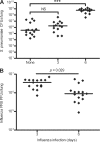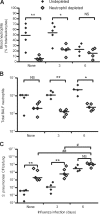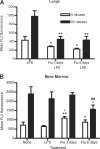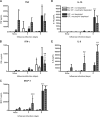Both influenza-induced neutrophil dysfunction and neutrophil-independent mechanisms contribute to increased susceptibility to a secondary Streptococcus pneumoniae infection
- PMID: 16982840
- PMCID: PMC1698099
- DOI: 10.1128/IAI.00789-06
Both influenza-induced neutrophil dysfunction and neutrophil-independent mechanisms contribute to increased susceptibility to a secondary Streptococcus pneumoniae infection
Abstract
Since secondary Streptococcus pneumoniae infections greatly increase the mortality of influenza infections, we determined the relative roles of neutrophil-dependent and -independent mechanisms in increased susceptibility to S. pneumoniae during influenza infection. Mice infected with influenza for 6 days, but not 3 days, showed a significant increase in susceptibility to S. pneumoniae infection compared to mice not infected with influenza. There was significant neutrophil accumulation in the lungs of S. pneumoniae-infected mice regardless of whether or not they were infected with influenza for 3 or 6 days. Depletion of neutrophils in these mice resulted in increased susceptibility to S. pneumoniae in both the non-influenza-infected mice and mice infected with influenza for 3 days but not in the mice infected with influenza for 6 days, indicating that a prior influenza infection of 6 days may compromise neutrophil function, resulting in increased susceptibility to a S. pneumoniae infection. Neutrophils from the lungs of mice infected with influenza for 3 or 6 days exhibited functional impairment in the form of decreased phagocytosis and intracellular reactive oxygen species generation in response to S. pneumoniae. In addition, neutrophil-depleted mice infected with influenza for 6 days were more susceptible to S. pneumoniae than neutrophil-depleted mice not infected with influenza, indicating that neutrophil-independent mechanisms also contribute to influenza-induced increased susceptibility to S. pneumoniae. Pulmonary interleukin-10 levels were increased in coinfected mice infected with influenza for 6 days but not 3 days. Thus, an influenza infection of 6 days increases susceptibility to S. pneumoniae by both suppression of neutrophil function and by neutrophil-independent mechanisms such as enhanced cytokine production.
Figures





 , P < 0.001. Data are expressed as means ± standard deviations. Data were analyzed using unpaired t test.
, P < 0.001. Data are expressed as means ± standard deviations. Data were analyzed using unpaired t test.


References
-
- Abramson, J. S., G. S. Giebink, E. L. Mills, and P. G. Quie. 1981. Polymorphonuclear leukocyte dysfunction during influenza virus infection in chinchillas. J. Infect. Dis. 143:836-845. - PubMed
-
- Abramson, J. S., and H. R. Hudnor. 1994. Effect of priming polymorphonuclear leukocytes with cytokines (granulocyte-macrophage colony-stimulating factor [GM-CSF] and G-CSF) on the host resistance to Streptococcus pneumoniae in chinchillas infected with influenza A virus. Blood 83:1929-1934. - PubMed
Publication types
MeSH terms
Substances
Grants and funding
LinkOut - more resources
Full Text Sources
Other Literature Sources

